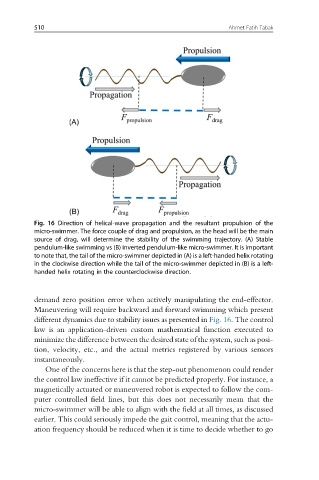Page 516 - Handbook of Biomechatronics
P. 516
510 Ahmet Fatih Tabak
Fig. 16 Direction of helical-wave propagation and the resultant propulsion of the
micro-swimmer. The force couple of drag and propulsion, as the head will be the main
source of drag, will determine the stability of the swimming trajectory. (A) Stable
pendulum-like swimming vs (B) inverted pendulum-like micro-swimmer. It is important
to note that, the tail of the micro-swimmer depicted in (A) is a left-handed helix rotating
in the clockwise direction while the tail of the micro-swimmer depicted in (B) is a left-
handed helix rotating in the counterclockwise direction.
demand zero position error when actively manipulating the end-effector.
Maneuvering will require backward and forward swimming which present
different dynamics due to stability issues as presented in Fig. 16. The control
law is an application-driven custom mathematical function executed to
minimize the difference between the desired state of the system, such as posi-
tion, velocity, etc., and the actual metrics registered by various sensors
instantaneously.
One of the concerns here is that the step-out phenomenon could render
the control law ineffective if it cannot be predicted properly. For instance, a
magnetically actuated or maneuvered robot is expected to follow the com-
puter controlled field lines, but this does not necessarily mean that the
micro-swimmer will be able to align with the field at all times, as discussed
earlier. This could seriously impede the gait control, meaning that the actu-
ation frequency should be reduced when it is time to decide whether to go

